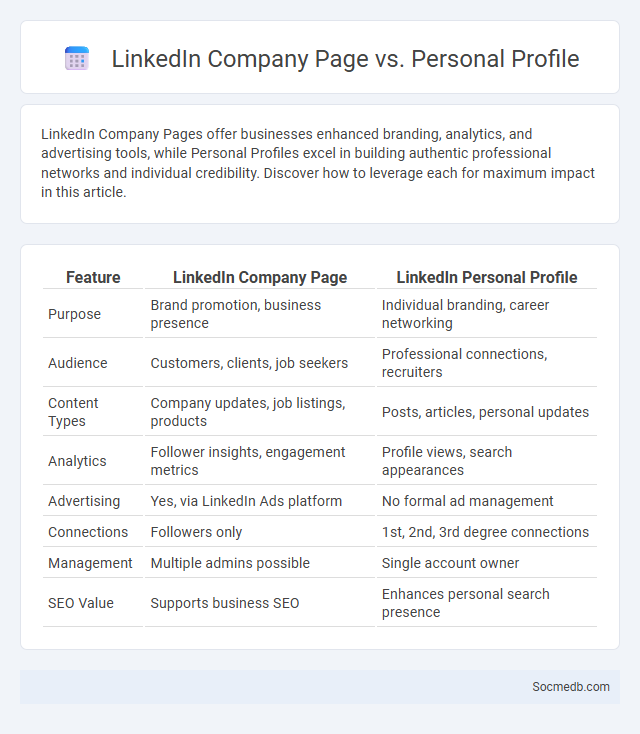
Photo illustration: LinkedIn Company Page vs Personal Profile
LinkedIn Company Pages offer businesses enhanced branding, analytics, and advertising tools, while Personal Profiles excel in building authentic professional networks and individual credibility. Discover how to leverage each for maximum impact in this article.
Table of Comparison
| Feature | LinkedIn Company Page | LinkedIn Personal Profile |
|---|---|---|
| Purpose | Brand promotion, business presence | Individual branding, career networking |
| Audience | Customers, clients, job seekers | Professional connections, recruiters |
| Content Types | Company updates, job listings, products | Posts, articles, personal updates |
| Analytics | Follower insights, engagement metrics | Profile views, search appearances |
| Advertising | Yes, via LinkedIn Ads platform | No formal ad management |
| Connections | Followers only | 1st, 2nd, 3rd degree connections |
| Management | Multiple admins possible | Single account owner |
| SEO Value | Supports business SEO | Enhances personal search presence |
Overview: LinkedIn Company Page vs Personal Profile vs Feed Ranking
LinkedIn Company Pages serve as official brand representations designed to share corporate updates, job postings, and industry insights, enhancing organizational visibility. Personal Profiles prioritize individual professional branding, showcasing skills, endorsements, and networking capabilities that drive authentic engagement. Feed ranking on LinkedIn favors content relevance, user interaction, and personalized connections, influencing the visibility of posts from Company Pages and Personal Profiles differently based on engagement metrics and algorithmic priorities.
Key Differences Between Company Pages and Personal Profiles
Company pages on social media offer specialized tools for branding, advertising, and analytics that personal profiles lack, making them essential for business growth. Your personal profile focuses on individual connections and sharing personal content, while company pages facilitate audience engagement, lead generation, and professional communication. Understanding these key differences ensures you leverage the right platform features to maximize your social media strategy effectively.
LinkedIn Feed Ranking: How Content Appears
LinkedIn Feed Ranking determines the visibility of posts by analyzing user interactions, content relevance, and post quality, ensuring personalized and engaging experiences for professionals. The algorithm prioritizes native content, such as articles, videos, and images, while penalizing external links that lead users away from the platform. Engagement metrics like comments, shares, and likes significantly influence ranking, promoting meaningful conversations and network growth within industry-specific feeds.
Pros and Cons of Personal Profile Engagement
Engaging with your personal profile on social media enhances connection by allowing authentic self-expression and fostering relationships with friends and followers. However, excessive sharing may lead to privacy risks, digital fatigue, and potential impacts on mental health due to online scrutiny or comparison. Balancing transparency with cautious content management ensures a positive and secure social media experience.
Advantages of Posting on Company Pages
Posting on company pages enhances brand visibility by reaching a targeted audience through tailored content and strategic engagement. It fosters customer trust and loyalty by providing consistent updates, addressing inquiries, and showcasing company values. This approach drives higher conversion rates and supports data-driven marketing decisions through analytics and user interaction feedback.
How LinkedIn Algorithm Ranks Company vs Personal Content
LinkedIn's algorithm prioritizes personal content by valuing individual engagement and authentic interactions, which often leads to higher reach compared to company pages focused on brand-centric posts. Your personal posts are ranked based on relevance, connections, and the likelihood of meaningful interactions such as comments and shares, whereas company content relies more heavily on broader audience targeting and sponsored promotion. Understanding these dynamics enables you to tailor your content strategy to maximize visibility and influence on LinkedIn.
Best Practices for Maximizing Feed Visibility
Consistently posting high-quality, engaging content tailored to your target audience significantly boosts social media feed visibility. Utilizing relevant hashtags, optimizing post timing based on audience activity, and encouraging user interaction through comments and shares are essential strategies. Leveraging platform-specific features like Stories, Reels, and live videos further enhances algorithm favorability, increasing content reach and engagement.
Content Strategy: Company Pages vs Personal Profiles
Developing a content strategy requires understanding the distinct purposes of company pages and personal profiles on social media. Company pages serve as official brand representatives, delivering consistent messaging, promotional content, and customer service, while personal profiles foster authentic engagement and relationship-building through personalized posts and interactions. Tailoring your content to leverage the strengths of both platforms enhances visibility, trust, and long-term audience growth.
Analytics: Measuring Success on Company and Personal Pages
Tracking key performance indicators such as engagement rate, reach, and conversion metrics allows you to accurately measure success on both company and personal social media pages. Utilizing advanced analytics tools like Facebook Insights, Google Analytics, and Instagram Insights provides actionable data to optimize content strategy and audience targeting. Understanding these metrics empowers your ability to drive growth, improve user interaction, and enhance overall social media ROI.
Choosing the Right Approach: Page, Profile, or Both?
Choosing the right social media approach depends on your goals, as pages are ideal for businesses seeking broad audience reach and analytics, while profiles suit personal branding and direct engagement. Combining both can maximize your presence by leveraging a business page's professional tools alongside a personal profile's authenticity. You should evaluate your target audience and content strategy to determine whether a page, profile, or a hybrid strategy aligns best with your objectives.
 socmedb.com
socmedb.com